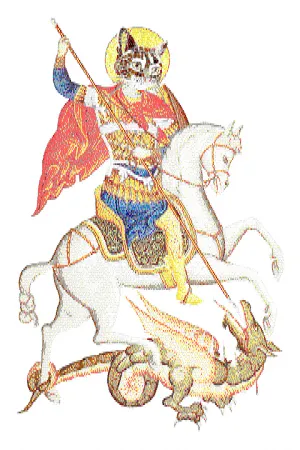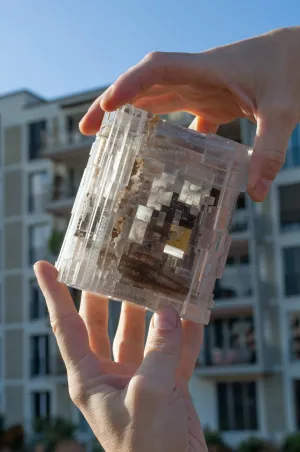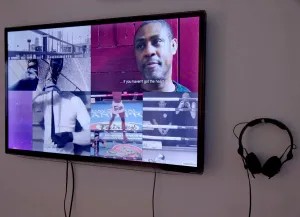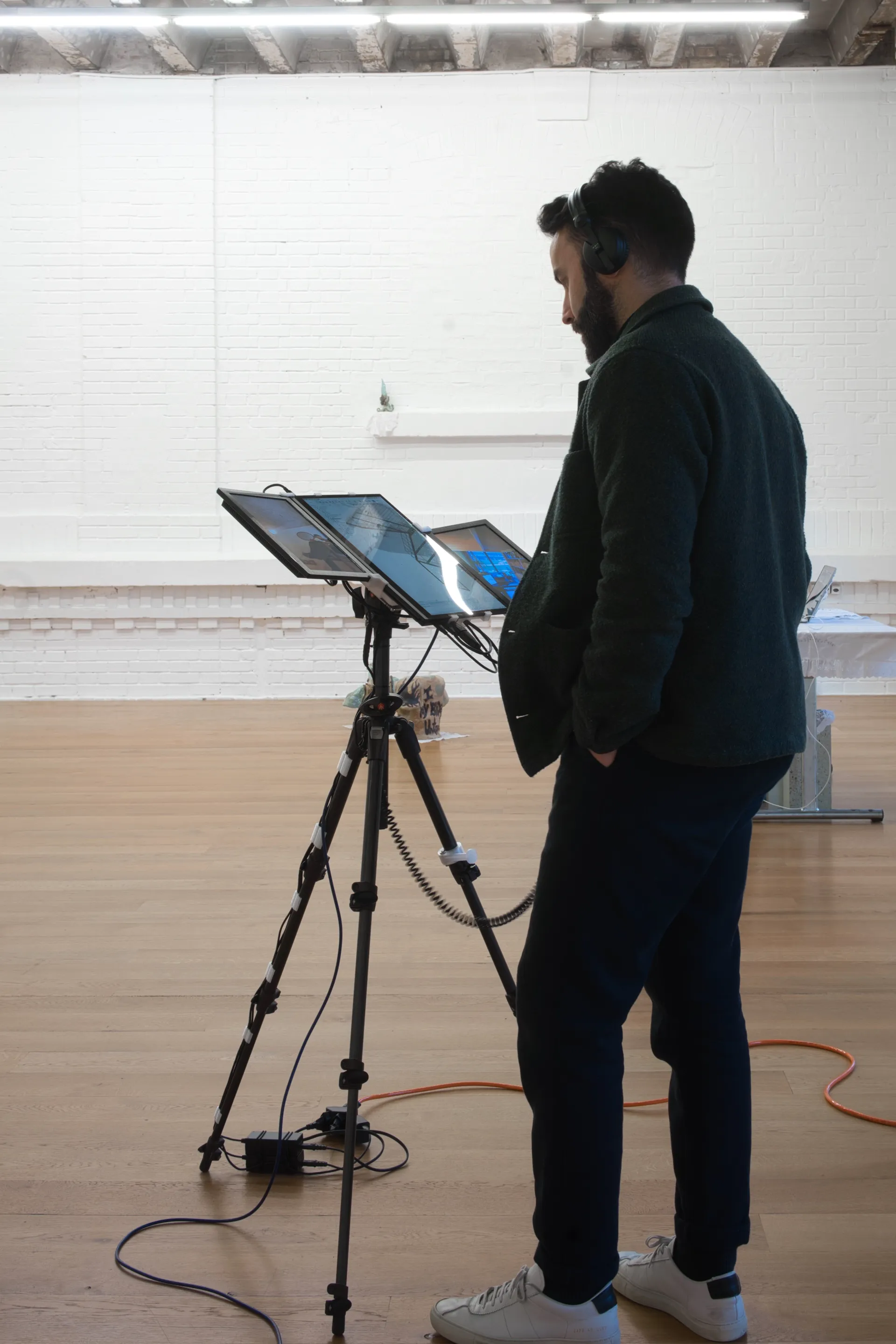
A Q U A R I U M
EN / Aquarium, 2024.
Basel, CH
Mischabbruch: Terrazzo Block with Integrated USB Drive, 2024.
Installation: terrazzo block with embedded USB drive, three screens on tripod with 3D-printed bracket, Raspberry Pi 4 micro-computer, orange heavy-duty power cord, headphones
4K video 5:55, Full HD videos (loop)
“Mischabbruch” was initiated by Jonas Huldi and Valentin Egli. As a prelude to the nomadic archive Mischabbruch, four terrazzo blocks made from the rubble of a demolished building, each with a USB stick embedded in such a way that it remains accessible, were exhibited at Kasko in Basel, Switzerland. This archival format, which promotes and applies the concept of self-organisation, offers an alternative to existing institutional archives, particularly with regard to the democratic self-organisation of content.
Daniel Vollmond and his partner Lynne Kouassi responded with their collaborative work Aquarium, which was installed directly on the USB drive embedded in the terrazzo block they received. The USB contained the operating system for the micro-computer as well as the video files and remained the sole digital vessel of the installation.
At the center of Aquarium is a screen recording of a digital architectural 3D drawing depicting a loft apartment. Gradually, the space is assembled: walls, water pipes, platforms, planks, and stairs - before being systematically deconstructed. The flanking screens show slow, continuous camera rotations of the corresponding real space: still under construction, yet already inhabited by Lynne and Daniel.
A female narrator recounts the story of the space as a live-work studio in a housing cooperative. The work reflects on themes of self-organisation, cooperation, unpaid labour, and the ambiguous position of the artist in Western society, celebrated for their supposed freedom (provided they are successful and profitable), yet often perceived as an expendable luxury: intriguing, but not really relevant.
DE / Aquarium, 2024.
Basel, CH
Mischabbruch: Terrazzo-Block mit integriertem USB-Stick, 2024
Installation: Terrazzo-Block mit integriertem USB-Stick, drei Bildschirme auf Stativ mit 3D-gedruckter Halterung, Raspberry Pi 4 Mikrocomputer, orangefarbenes Starkstromkabel, Kopfhörer
4K-Video 5:55, Full-HD-Videos (Loop)
„Mischabbruch“ wurde von Jonas Huldi und Valentin Egli initiiert. Als Auftakt des nomadischen Archivs „Mischabbruch“ wurden im Kasko in Basel vier Terrazzoblöcke aus dem Schutt eines abgerissenen Gebäudes ausgestellt, jeweils mit einem USB-Stick versehen, der so eingelassen war, dass er weiterhin zugänglich blieb. Dieses Archivformat, das das Prinzip der Selbstorganisation fördert und praktisch anwendet, versteht sich als Alternative zu bestehenden institutionellen Archiven, insbesondere im Hinblick auf eine demokratische Selbstorganisation und Verbreitung von Inhalten.
Daniel Vollmond und seine Partnerin Lynne Kouassi reagierten darauf mit ihrer Gemeinschaftsarbeit Aquarium, die direkt auf dem USB-Laufwerk installiert wurde, das in den erhaltenen Terrazzoblock eingelassen war. Der USB-Stick enthielt das Betriebssystem für den Mikrocomputer sowie die Videodateien und blieb das einzige digitale Medium der Installation.
Im Zentrum von Aquarium steht die Bildschirmaufnahme einer digitalen architektonischen 3D-Zeichnung eines Loft-Apartments. Schritt für Schritt wird der digitale Raum aufgebaut – Wände, Wasserleitungen, Plattformen, Dielen und Treppen – bevor er systematisch wieder dekonstruiert wird. Die flankierenden Bildschirme zeigen langsame, kontinuierliche Kamerarotationen durch den entsprechenden realen Raum: noch im Umbau, aber bereits von Lynne und Daniel bewohnt.
Eine weibliche Stimme erzählt die Geschichte des Raums als Wohn- und Arbeitsatelier innerhalb einer Wohnbaugenossenschaft. Die Arbeit reflektiert Themen wie Selbstorganisation, Kooperation, unbezahlte Arbeit und die ambivalente Rolle von Künstler:innen in der westlichen Gesellschaft – einerseits gefeiert für ihre vermeintliche Freiheit (sofern sie erfolgreich und profitabel sind), andererseits betrachtet als verzichtbarer Luxus: faszinierend, aber nicht wirklich relevant.

„We recently moved into a live-work studio. I’m afraid my work-life-balance won’t improve here, but still we are very happy about it. Because now we finally have a home that is not mouldy. AND the heating is working. Our new home costs 1’210 CHF per month, that is 200 CHF less than all the other cheap but bearable flats we could find. However, the reason for the low price is, that the space came without a kitchen and with a floor area of just 35 square meters. (Plus a small bathroom with a toilet, a shower cabin, a sink and a nice built-in cabinet.) One might think, that this isn’t a lot of space for two adults. But luckily, we are allowed to design, build and install a kitchen and a second floor to increase our comfort and the number of usable square meters. The only thing we need is time, motivation, creativity, know-how, energy, money, and some support. We do have motivation, creativity and quite a bit of know-how. I guess, that’s a start.
Our new home is part of a housing cooperative - which is cool. They created a solidarity fund that should balance out the different incomes of all neighbours. Members who earn more automatically pay into this fund so that other members with lower income can be supported financially. When we signed the contract we asked for support from this fund. We declared our full income and that we did not have a retirement arrangement, which we would like to organise rather sooner than later. But unfortunately, our request was rejected. We were told that they don’t understand why we earn so little, because we are both young and able to work. Yes, we do work full time - often even more than that. But artistic labour does not pay. Believe me: I also don’t know why. Despite being recognised as professional artists, we have to find other ways to earn extra money. But our additional jobs cost time and energy and also don’t bring in a fortune. Even worse: often we spend money we earn in other jobs to provide for art!
In her book Art Work Katja Praznik asks the question: „Who can afford the unpaid labour?“. But in our case the question rather is: „In what currency must we pay to be able to afford the unpaid labour?“ In safety, security, comfort, social visibility or health? Sometimes I do ask myself if I sacrificed my position as a desirable human being in Western society when I chose to become an artist. I mean think about it: artists continuously work for society by creating meaning and by asking the relevant questions. But only if their work can be turned into a product and only if it is sold as a commodity, then the artistic labour is profitable and accepted as real and human labour. This is the moment when society envies us for our so-called freedom. But until then, society perceives artists more as something like ornamental fish swimming in an aquarium: a debatable luxury. Or something like mountain goats balancing high up in the cliffs over the abyss: Somewhat fascinating, but not really regarded as relevant.“
Lynne Kouassi & Daniel Vollmond
Basel, 27.02.2023
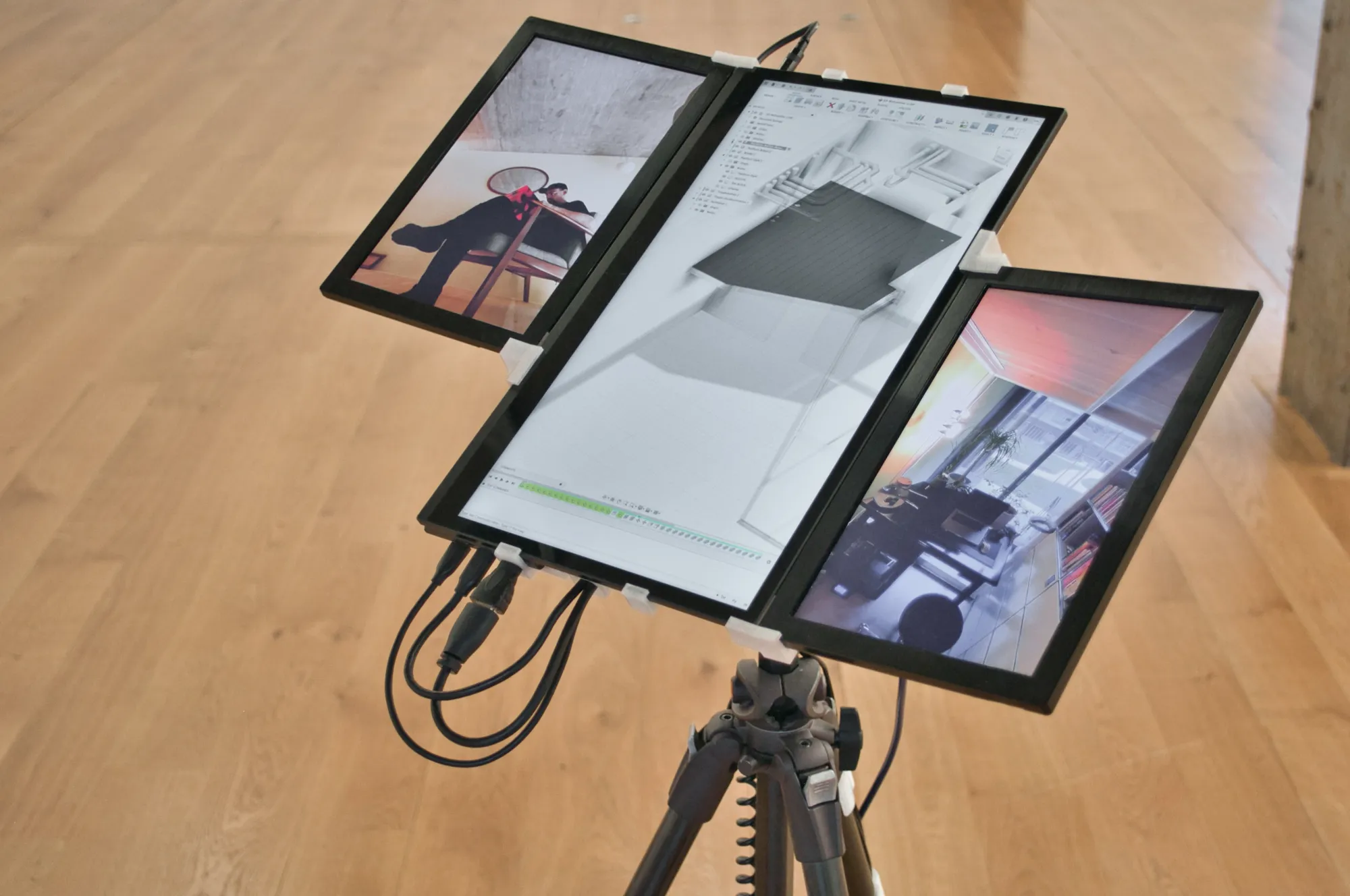
Aquarium
loop - web version
Mischabbruch - Nomadisches Archiv
02.03. – 03.03.2024, KASKO Basel (CH)
Curated by Valentin Egli & Jonas Huldi
Participating Artists:
Chris Handberg & Markus Åbersold, Salomé Jokhadzke, Janis Labhart, Lynne Kouassi & Daniel Vollmond
KASKO / ✧( ु•⌄• )◞◟( •⌄• ू )✧ /
Werkraum Warteck pp
Burgweg 7-15
4058 Basel
Switzerland


